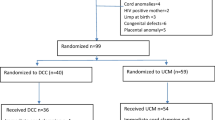Abstract
Purpose
Normal labor curves have not been assessed for women undergoing a trial of labor after cesarean delivery (TOLAC). This study examined labor patterns during TOLAC in relation to epidural analgesia use.
Methods
Retrospective cohort study of deliveries of women undergoing TOLAC at a single, academic, tertiary medical center. Length of first, second and third stages of labor was compared between 424 women undergoing TOLAC in the current labor with no previous vaginal delivery (VD) and 357 women with at least one previous VD and current TOLAC.
Results
Women in the TOLAC only group had significantly longer labors compared to women in the previous VD and TOLAC group. In both groups, women who underwent epidural analgesia had longer first and second stages of labor. In the TOLAC only group, more women who had epidural analgesia tended to deliver vaginally as compared to those who did not (P = 0.09). For women who delivered vaginally, the 95th percentile for the second stage duration with epidural was 3.40 h in the TOLAC only group and 2.3 h in the previous VD and TOLAC group. The 95th percentile for the second stage duration without epidural was 1.4 h in the TOLAC only group and 0.9 h in the previous VD and TOLAC group.
Conclusions
Operative intervention (instrumental delivery/cesarean delivery (CD)) might be considered for women attempting TOLAC after a 2-h duration of second stage without epidural and 3-h duration with epidural, with an hour less for women who also had previous VD.



Similar content being viewed by others
References
Friedman E (1955) The graphic analysis of labor. Am J Obs Gynecol. 6(6):567–589
Friedman E (1978) Labor clinical evaluation and management. Appleton-Century-Crofts, New York
Zhang J, Troendle J, Mikolajczyk R (2010) The natural history of the normal first stage of labor. Obstet Gynecol 115(4):705–710
Zhang J, Landy HJ, Branch DW, Burkman R (2010) Contemporary patterns of spontaneous labor with normal neonatal outcomes. Obstet Gynecol 116(6):1281–1287
Uddin SFG, Simon AE (2013) Rates and success rates of trial of labor after cesarean delivery in the United States, 1990–2009. Matern Child Heal J 17:1309–1314
Cunningham FG, Leveno KJ et al (2009) Williams obstetrics, 23rd edn. Appleton-Century-Crofts, New York
Landon MB, Hauth JC, Leveno KJ, Spong CY, Leindecker S, Varner MW, Moawad AH, Caritis SN, Harper M, Wapner RJ, Sorokin Y, Miodovnik M, Carpenter M, Peaceman AM, O’Sullivan MJ, Sibai B, Langer O, Thorp JM, Ramin SM, Mercer BMGS (2004) Maternal and perinatal outcomes associated with a trial of labor after prior cesarean delivery. N Engl J Med 351(25):2581–2589
Grantz KL, Gonzalez-quintero V, Troendle J, Reddy UM, Hinkle SN, Kominiarek MA (2016) Labor patterns in women attempting vaginal birth after cesarean with normal neonatal outcomes. Am J Obstet Gynecol 213(2):226.e1–226.e6
Hueston WJ, McClaflin RR, Mansfield CJRM (1994) Factors associated with the use of intrapartum epidural analgesia. Obs Gynecol 84(4):579–582
O’Hana HP, Levy A, Rozen A, Greemberg L, Shapira Y SE. The effect of epidural analgesia on labor progress and outcome in nulliparous women. J Matern Fetal Neonatal Med 21:517–521
Decca L, Daldoss C, Fratelli N, Lojacono A, Slompo M, Stegher C et al (2004) Labor course and delivery in epidural analgesia: a case-control study. J Matern Fetal Neonatal Med 16:115–118
Anim-Somuah M, Smyth RMDJL (2011) Epidural versus non-epidural or no analgesia in labour. Cochrane Database Syst Rev 12:CD000331
Worstell T, Ahsan A, Cahill CA (2014) Length of the second stage of labor: what is the effect of an epidural? Obstet Gynecol 12:CD000331
Guise JM, Eden K, Emeis C, Denman MA, Marshall N, Fu RR, Janik R, Nygren P, Walker M (2010) Vaginal birth after cesarean: new insights. Evid Rep Technol Assess 191:1–397
Nguyen US, Rothman KJ, Demissie S, Jackson DJ, Lang JMEJ (2010) Epidural analgesia and risks of cesarean and operative vaginal deliveries in nulliparous and multiparous womens. Matern Child Health 14:705–712
Eriksen LM, Nohr EAKH (2011) Mode of delivery after epidural analgesia in a cohort of low-risk nulliparas. Birth 38:317–326
Consensus OC (2014) Safe prevention of the primary cesarean delivery. ACOG
Hung T, Hsieh T, Liu H (2015) Differential effects of epidural analgesia on modes of delivery and perinatal outcomes between nulliparous and multiparous women : a retrospective cohort study. PLoS One 10(3):1–11. https://doi.org/10.1371/journal.pone.0120907
Salman L, Hiersch L, Shmueli A, Krispin E, Wiznitzer A G-BR (2018) Complicated primary cesarean delivery increases the risk for uterine rupture at subsequent trial of labor after cesarean. Arch Gynecol Obs 298(2):273–277
Ram M, Hiersch L, Ashwal E, Nassie D, Lavie A, Yogev YAA (2018) Trial of labor following one previous cesarean delivery: the effect of gestational age. Arch Gynecol Obs. 297(4):907–913
Gobillot S, Ghenassia A, Coston AL, Gillois P, Equy V, Michy T HP (2018) Obstetric outcomes associated with induction of labour after caesarean section. J Gynecol Obs Hum Reprod. https://doi.org/10.1016/j.jogoh.2018.09.006 (Epub ahead of print)
Harper LM, Cahill AG, Roehl KA et al (2012) The pattern of labor preceding uterine rupture. Am J Obs Gynecol 207:210.e1–6
Zelop CM, Shipp TD, Repke JT et al (1999) Uterine rupture during induced or augmented labor in gravid women with one prior cesarean delivery. Am J Obs Gynecol 181:882–886
Funding
The study was not funded.
Author information
Authors and Affiliations
Contributions
NM: data Collection, Statistical analysis, Manuscript writing. MP: data Collection, Manuscript writing. NH-Y: data collection. YD: data collection. YP: manuscript writing. TB-S: manuscript review and revision. All authors agree with the final version, as submitted.
Corresponding author
Ethics declarations
Conflict of interest
The authors declare that they have no conflict of interest.
Human and animal rights
This article does not contain any studies with human participants or animals performed by any of the authors.
Rights and permissions
About this article
Cite this article
Miller, N., Pelleg, M., Hag-Yahia, N. et al. Labor progression of women attempting vaginal birth after previous cesarean delivery with or without epidural analgesia. Arch Gynecol Obstet 299, 129–134 (2019). https://doi.org/10.1007/s00404-018-4956-5
Received:
Accepted:
Published:
Issue Date:
DOI: https://doi.org/10.1007/s00404-018-4956-5




